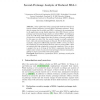Free Online Productivity Tools
i2Speak
i2Symbol
i2OCR
iTex2Img
iWeb2Print
iWeb2Shot
i2Type
iPdf2Split
iPdf2Merge
i2Bopomofo
i2Arabic
i2Style
i2Image
i2PDF
iLatex2Rtf
Sci2ools
ACISP
2010
Springer
2010
Springer
Second-Preimage Analysis of Reduced SHA-1
Many applications using cryptographic hash functions do not require collision resistance, but some kind of preimage resistance. That's also the reason why the widely used SHA-1 continues to be recommended in all applications except digital signatures after 2010. Recent work on preimage and second preimage attacks on reduced SHA-1 succeeding up to 48 out of 80 steps (with results barely below the 2n time complexity of brute-force search) suggest that there is plenty of security margin left. In this paper we show that the security margin is actually somewhat lower, when only second preimages are the goal. We do this by giving two
2n Time Complexity | ACISP 2010 | Cryptographic Hash Functions | Security Margin | Security Privacy |
| Added | 09 Feb 2011 |
| Updated | 09 Feb 2011 |
| Type | Journal |
| Year | 2010 |
| Where | ACISP |
| Authors | Christian Rechberger |
Comments (0)

